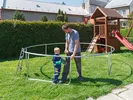By continuing to use this site, you agree to our use of cookies.
Moving Swing Sets, Swimming Pools and Other Outdoor Equipment
Jul 1, 2025
Transporting backyard fun to a new home
The best family memories are often made outside in the backyard. Whether your space is a quiet outdoor oasis or a nonstop, kid-friendly fun spot, you’ll want to make sure you have everything you need to recreate it at your new home.
How you pack and move outdoor equipment depends on the item. Following professional packing tips is always a good idea while preparing for a long-distance move, but some things require special care. We’ve gathered some item-specific advice to keep your outdoor things safe during transit.

Preparing to move outdoor toys and equipment
Following the proper steps before loading outdoor equipment will save time and make unloading and reassembly easier at the new place.
To get started, gather the following items:
- Corrosion solvent (helpful if any nuts and bolts have rust)
- Heavy-duty work gloves
- Measuring tape
- Old towels or rags and multi-purpose cleaner or dish soap
- Packing supplies: Moving blankets, plastic stretch wrap, packing tape, permanent marker (for labeling), moving boxes, garbage bags, zip-top bags
- Phone or digital camera for taking pictures
- Product manual (look for a PDF online if you don’t have the original)
- Tool kit (wrenches, pliers, Allen keys, screwdrivers, spring tool for trampolines, etc.)
Inspect for insects
Some areas of the U.S. are under quarantine for invasive insects like the spongy moth or the spotted lanternfly. Those locations will require you to complete an invasive species checklist to ensure you don’t transport the bugs while moving.
Whether you are relocating within the affected areas or not, it’s a good idea to inspect all outdoor items for signs of bugs. Remove live insects and eggs so the critters won’t hitch a ride with your stuff!
How to move outdoor belongings
Follow these guidelines to make moving your backyard staples easier.
Moving swing sets
If you built your family’s swing set, you know it typically arrives in multiple pieces. The best way to move it to a new home is to take it apart — but don’t worry, not all the way apart. You can disassemble the set just enough to make it fit inside the moving equipment and to keep any non-stationary parts secure.
Follow these steps:
- Take photos of the playset from different angles for reference. Include major connections and attachments for accessories like slides, monkey bars and swings.
- Spray corrosion solvent on any rusted connections to loosen nuts and bolts.
- Measure the main pieces to ensure they’ll fit in the moving equipment.
- Wipe down the swing set to remove dirt and debris. Make sure to wear work gloves to avoid splinters.
- Follow instructions in the manual to remove accessories from the main structure.
- Disconnect the cross sections and set aside.
- Place nuts and bolts into a zip-top bag.
- Break down the rest of the frame into pieces to fit inside the moving equipment. Take pictures of each step to help with reassembly.
- Bundle larger pieces in moving blankets. Secure with plastic stretch wrap and packing tape.
- Place smaller components and bags of connectors into small moving boxes. Make sure to label everything.
- Load carefully into the moving equipment. Larger pieces usually fit well along the sides of the moving trailer or container.
Relocating above-ground swimming pools
Above-ground swimming pools can be a lot of fun, and if you think moving one seems challenging, you’re not alone. Fortunately, it is possible to safely move a pool.
- Consult the manual for proper cleaning and disassembly instructions.
- Disconnect and clean the pool filter. Dry everything completely. Pack the pump inside a moving box and contain hoses in a garbage bag before packing them in a box.
- Remove the pool ladder. Clean and dry it thoroughly. Disassemble and pack into a box or transport it as is if you have room in the moving equipment.
- Ensure that the pool is drained, clean and dry. Dryness is especially important to avoid mildew.
- Fold or roll the pool liner according to the manufacturer’s instructions. For transport, place it inside a large garbage bag or inside a moving blanket secured with plastic stretch wrap.
- Disconnect the pool frame, using corrosion solvent if needed. Take pictures of each step and store small pieces in zip-top bags.
- Wrap bundles of frame parts in moving blankets secured with plastic stretch wrap.
- If possible, load pool parts along the sides of the equipment so they won’t damage other items. Place the liner in a spot where it won’t get creased or have heavy things sitting on top.
Transporting trampolines
Trampolines are a bouncing good time, but they can’t be moved long-distance easily without taking them apart. Here’s how:
- Clean and dry the trampoline.
- Follow the manufacturer’s instructions to remove the safety netting and pads.
- Start mat removal by hooking the spring tool to each spring and extending until they come loose. Be careful and wear work gloves during this step.
- Place the springs in a zip-top bag before packing them in a moving box.
- Fold the mat and netting into small bundles. Wrap them in a moving blanket secured by plastic stretch wrap.
- Disassemble the frame, ladder and legs, using corrosion solvent if needed. Take photos of each step. Place all parts in bundles wrapped in moving blankets and plastic stretch wrap.
- Load everything in a secure location inside the moving equipment.
Moving outdoor furniture and other items
Follow the manufacturer’s instructions for disassembling and moving other outdoor items like furniture, sports equipment and lawn maintenance tools. Use professional packing tips and loading advice to keep everything safe.
Disconnect any batteries and drain fluids when applicable. Make sure to consult your moving service’s Do Not Ship List to avoid loading anything prohibited into the moving equipment.
Is it better to leave outdoor equipment behind instead of moving it?
If you don’t have the space to transport outdoor equipment, it might be best to leave it behind for the new owners (or renters) if they want it. You could also sell large outdoor toys and playsets in a moving sale or through a platform like Facebook Marketplace and use the money to purchase new (or gently used) items once you’re settled in at the new home.
Have questions about moving your backyard basics?
For other questions or concerns about moving outdoor equipment and toys, let us know in the comments.
If you’re still planning your out-of-state move, don’t miss out on a free quote from U-Pack®! Our flexible moving equipment options make it easy to bring along backyard fun with your household belongings.
Call 844-362-5303844-594-3077 to speak with a moving consultant or start your quote online.
More articles you might like...



